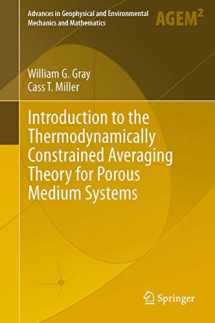
Introduction to the Thermodynamically Constrained Averaging Theory for Porous Medium Systems (Advances in Geophysical and Environmental Mechanics and Mathematics)
ISBN-13:
9783319040097
ISBN-10:
331904009X
Edition:
2014
Author:
William G. Gray, Cass T. Miller
Publication date:
2014
Publisher:
Springer
Format:
Hardcover
582 pages
Category:
Geography
,
Earth Sciences
,
Geology
,
Geophysics
,
Physics
,
Mineralogy
FREE US shipping
Book details
ISBN-13:
9783319040097
ISBN-10:
331904009X
Edition:
2014
Author:
William G. Gray, Cass T. Miller
Publication date:
2014
Publisher:
Springer
Format:
Hardcover
582 pages
Category:
Geography
,
Earth Sciences
,
Geology
,
Geophysics
,
Physics
,
Mineralogy
Summary
Introduction to the Thermodynamically Constrained Averaging Theory for Porous Medium Systems (Advances in Geophysical and Environmental Mechanics and Mathematics) (ISBN-13: 9783319040097 and ISBN-10: 331904009X), written by authors
William G. Gray, Cass T. Miller, was published by Springer in 2014.
With an overall rating of 3.7 stars, it's a notable title among other
Geography
(Earth Sciences, Geology, Geophysics, Physics, Mineralogy) books. You can easily purchase or rent Introduction to the Thermodynamically Constrained Averaging Theory for Porous Medium Systems (Advances in Geophysical and Environmental Mechanics and Mathematics) (Hardcover) from BooksRun,
along with many other new and used
Geography
books
and textbooks.
And, if you're looking to sell your copy, our current buyback offer is $0.3.
Description
Thermodynamically constrained averaging theory provides a consistent method for upscaling conservation and thermodynamic equations for application in the study of porous medium systems. The method provides dynamic equations for phases, interfaces, and common curves that are closely based on insights from the entropy inequality. All larger scale variables in the equations are explicitly defined in terms of their microscale precursors, facilitating the determination of important parameters and macroscale state equations based on microscale experimental and computational analysis. The method requires that all assumptions that lead to a particular equation form be explicitly indicated, a restriction which is useful in ascertaining the range of applicability of a model as well as potential sources of error and opportunities to improve the analysis.


We would LOVE it if you could help us and other readers by reviewing the book
Book review

Congratulations! We have received your book review.
{user}
{createdAt}
by {truncated_author}


